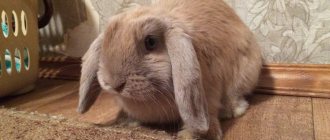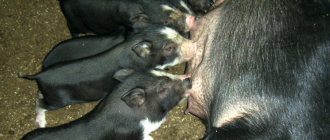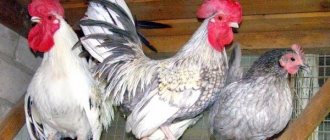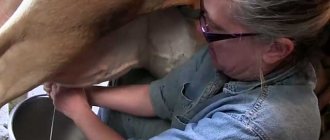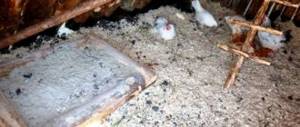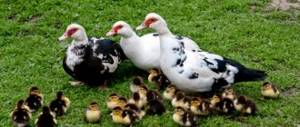Profitability of rabbit breeding
A home rabbit farm can become a source of stable profit for the owner. One kilogram of meat from these animals costs an average of 450 rubles. One animal gives 1.5-2 kg, and it reaches this weight already at 4 months. One female produces from 25 to 60 heads of young animals per year, that is, from 40 to 120 kilograms of meat or from 18,000 to 54,000 rubles.
If there are 300 females on a farm, revenue from meat alone can reach 16 million rubles. Of course, part of these funds will have to be spent on feed and livestock renewal. With age, the fertility of females decreases; they need to be replaced with new individuals, as well as dilute closely related families with new animals. However, fertility, the rate of birth of new rabbits and the rapid increase in slaughter weight make maintenance costs very modest.
All initial investments can actually be recouped within a year of work. The fact that rabbits are raised not only for meat, but also for fur and for decorative purposes (although decorative breeds differ) has a positive effect on profitability.
Even a beginner can keep rabbits
Basic expenses
A rabbit farm business project should start by calculating expenses. What investments and in what areas will be required:
- preparation of premises and cages - from 50 thousand rubles;
- purchase of individuals (100 rabbits) - 50 thousand rubles (price may vary depending on the breed);
- feed - from 20 thousand rubles;
- tools for slaughter, processing of hides and meat - from 5 thousand rubles;
- utility room - from 10 thousand rubles;
- refrigerator or freezer - from 10 thousand rubles;
- associated expenses - from 10 thousand rubles.
Thus, the total cost of creating a rabbit farm will be about 155–160 thousand rubles. This is relatively small compared to other livestock sectors. Even a mini rabbit farm will cover these costs within 1 year of operation.
Pros of a rabbit farm as a business
Farmers who want to produce rabbits commercially on a large scale should use large pens as rabbits reproduce very quickly. An aspiring entrepreneur can make a profit within six to eight months after starting a rabbit business from scratch. Once the business has grown, you can expect weekly or monthly income depending on the frequency of meat processing.
Short life cycles of rabbits
Rabbit farming as a business is very effective as the life cycle of one rabbit is much shorter than the life cycle of any other domestic animal. The female reaches sexual maturity at the age of several months and remains fertile all year round. The gestation period lasts about 1 month. Babies are weaned after four or five weeks, but mothers are ready for fertilization soon after giving birth, although experts recommend waiting at least two weeks before breeding again to avoid stress on mothers. On a 14- or 21-day schedule, you will get seven to eight litters per year.
Rabbits eat little
Rabbits consume much less food than any other pet. Every ruble saved on feed is a ruble that will go towards business development. Since your rabbits replace part of your diet, you can consider them as an indirect reduction in your grocery budget.
Rabbits do not require specialized nutrition
You can successfully raise your rabbits on an unlimited amount of plant foods, root vegetables, and hay. You can also add grains. Rabbits will eat almost any plant food collected from the outdoors. However, as a precaution, you should rinse all food thoroughly with plenty of water. You do this to remove dust, manure and insects, as well as to clean the feed from contamination by infections. After washing, allow the food to dry for several hours before serving.
Rabbits do not disturb others
Considering all the circumstances of running a farm, rabbits are very calm animals. They are not as noisy or smelly as goats or poultry. As long as you have an effective waste reduction plan and good anti-predation protection, your neighbors should have no reason to complain about your backyard rabbit farming business.
Paperwork
First, you can breed rabbits as part of your personal subsidiary plot - for yourself and your family. However, in this case it is impossible to sell meat, because private household plots do not require the payment of taxes. This option is not suitable for business. It is better to register an individual entrepreneur or LLC, then the meat can officially be sold to retail chains, private clients, or even in your own store.
We will look at taxation in more detail in the corresponding section. Now it’s only worth mentioning that for this livestock industry you can choose a very convenient preferential Unified Agricultural Tax regime. To sell meat, you will have to pass a health inspection. When purchasing livestock from a breeder, you must request documents confirming the health of the animals.
Registration of documents for the farm will take 1-2 months, and most likely it will go even faster.
Description of the industry and company
The history of rabbit breeding as an industry in our country began in 1927, when, by order of the USSR government, about 15 thousand purebred rabbits from Europe were brought to the Western republics. By 1961, the USSR had become one of the world leaders in rabbit breeding: 56.7 million rabbit skins and 41.2 thousand tons of live weight were harvested. 95% of the country's production came from the previously popular domestic rabbit breeding, and about 400 farms provided the population with breeding breeds. The collapse of the USSR led to the almost complete disappearance of rabbit breeding as an industry. Most enterprises closed, and it became unprofitable to raise rabbits on an industrial scale.
Nowadays, rabbit breeding is gradually being revived, and the volume of production is gradually increasing. According to the expert-analytical center “AB-Center”, the volume of rabbit meat production over five years increased by 21.5% and amounted to 17.5 thousand tons, of which the largest share is occupied by households, which account for 13.5 thousand tons products. The highest growth rates are demonstrated by the commodity sector, whose volumes have grown by 60% over five years. Accordingly, the livestock is also growing. According to Rosstat, the number of rabbits in Russia has more than doubled since the beginning of the 2000s and exceeded the figures of the 1990s.
The majority of the rabbit population, as of the end of 2015, falls on household farms - 82.8%. The share of agricultural organizations is 11.3%, individual entrepreneurs and peasant farms own 5.79% of the livestock.
Industry experts emphasize that the domestic rabbit breeding market is in its formation stage and demand will grow for a long time. Unmet demand, according to rough estimates, exceeds 320 thousand tons. If we take today’s production volumes, it turns out that each Russian consumes only 119 grams of rabbit meat per year, while Europeans eat 2 kg of rabbit meat per year.
After the collapse of the USSR, most of the products began to come from abroad. However, the share of imports began to decline every year. If in 2006 it was 97.2%, then in 2010 it was 72.2%. In 2015, after the devaluation of the ruble and the introduction of sanctions, the share of imports is estimated at approximately 9%. This situation aroused the interest of large businesses - in the near future, several large players are expected to appear on the Russian market who will be able to fill the unsatisfied demand that has arisen after products from Hungary and China disappeared from the shelves.
Despite the increase in the share of large players, the market is far from saturation, so the business of medium- and small-sized farms will remain a relevant area of entrepreneurship for a long time. Unlike large companies, they work for local demand: they are not allowed to enter large retail chains due to the low volumes of products produced. In addition, the main method used for keeping rabbits is open keeping with the help of sheds, while large enterprises use closed keeping, automatic systems for maintaining the microclimate, supplying water and feed, and removing manure.
The farm planned for opening will work using the most common shad technology today, the use of which is justified by the small planned production volume and low cost of creation. The farm will be opened in the countryside, on its own land plot of 1000 square meters. meters. The area of the sheds will be 360 square meters. meters (3 sheds) and will allow you to get up to 1000 heads of young animals per year (up to 1000 skins and about 2000 kg of meat).
The business will be registered as an individual entrepreneur. For breeding, 100 breeding young animals will be purchased. Since the main source of income for the farm will be meat, preference is given to the Californian beef breed. This breed is characterized by high productivity, survival of young animals and unpretentiousness.
The meat is planned to be sold to owners of outlets at meat markets. The average price per carcass will be 400 rubles, which is the average price on the market today. An additional source of income will be the sale of rabbit skins at 40 rubles per carcass. It is also possible to sell the waste remaining after the slaughter of rabbits (rabbit ears, vermicompost, etc.).
The starting investment in opening a farm will be 636.5 thousand rubles. Source: own funds. Start-up cost items will include costs for creating shads, purchasing breeding stock, etc. More detailed items of starting costs are given in Table. 1 business plan.
Table 1. Investment costs of the project
| № | NAME | AMOUNT, rub. |
| Creating shades | ||
| 1 | Creation of sheds (building materials, site arrangement) | 242 000 |
| Equipment | ||
| 2 | Equipment for utility rooms | 100 000 |
| 3 | Feed production equipment | 82 500 |
| 4 | Refrigeration equipment | 52 000 |
| 5 | Other equipment | 50 000 |
| Intangible assets | ||
| 6 | Registration, advertising | 30 000 |
| Working capital | ||
| 7 | Working capital | 30 000 |
| 8 | Purchase of young animals | 50 000 |
| Total: | 636 500 | |
The main work to ensure the operation of the farm and all production responsibilities will fall on the shoulders of the project initiator. Supporting functions will be performed by family members of the initiator. To open a farm, a preparatory period of 3 months will be required, which is necessary for the construction of shads, the purchase of breeding stock, and the purchase of some equipment. An agreement has been reached on the sale of products, a drawing of the shed structure is available, the site has been prepared, and the necessary building material has been purchased.
How to choose a breed for breeding
Depending on the specialization of the farm, the breed for breeding is determined. There are at least 200 species of rabbits in the world, but only about 20 of them can grow well in Russia. A reliable breeder from whom the farmer will purchase the first animals for the livestock must provide documents for the animals. Crimea and the Berkeyevo peasant farm in the Ryazan region enjoy a good reputation in this regard.
All breeds are divided into:
- meat;
- fur;
- decorative;
- downy
The best meat breeds:
- California rabbit. White rabbits with a short body and small head. They are very prolific and quickly gain weight, which is why farmers love them. Slaughter weight is about 5 kg at 5 months, while the skeleton is very thin and light. They tolerate heat and cold well.
- Soviet chinchillas. Gray animals with a wide chest. 4 kg weigh approximately at 4 months. Fur color is uneven. Prolific: the female brings at least 8 rabbits at a time. They are also not afraid of cold weather and develop quickly.
- Black-brown rabbits. Animals with a large head and long ears (up to 18 centimeters). The skin is of great value due to its color. Adults can grow up to 7 kg.
- Silver rabbit. Animals of medium size with strong limbs and a wide chest. They grow well even in cold climates, reaching 6 kg.
Rabbits are kept in cages or enclosures
The best down and fur breeds:
- Angora down. They weigh much less than meat breeds - only 3 kg - and are less fertile. The fur is long and thick, reminiscent of the goat of the same name. Such animals are sheared at least once every 3 months. You need a dry, warm room.
- White downy. A slightly heavier breed - up to 4 kg. Long and elastic fur up to 15 cm, does not tangle or roll down. Animals adapt well to any weather conditions.
- Voile silver. Animals with bluish skins are initially born black and lighten after 7-8 months.
- Butterfly. White and black animals with a small head and body. The fur is short but dense. Valued for dark decorative spots on the skin.
- Rex. Short-haired rabbit with velor fur. Colors range from white to black and spotted. Infertile, grow slowly, but have a calm, friendly character. They don't like noise and heat. These are grown on farms in Siberia. Popular as pets.
How much can you sell rabbit meat for?
Commercial meat processing plants pay between 200 and 300 rubles per kilogram of live rabbits. If you process rabbit meat on site, expect to receive between 300 and 400 rubles per kilogram, depending on the quality of the meat. As a small company, you will struggle to find butchers willing to buy small quantities. If you don't have the space, resources, or legal space to process your own meat, sell the live rabbits you produce and reinvest the proceeds into your operation.
Features of keeping animals
There are several methods for keeping rabbits:
- in cells;
- in enclosures;
- in pits;
- on pasture.
Cellular content is considered traditional. Animals grow in cages 1x0.5x05 m, the design of which is adapted to all their needs. Cages can be mobile or stationary, depending on the characteristics of the farm. Usually they are placed on top of each other in tiers. This housing option allows for rational use of feed, caring for animals and monitoring their health. There is only one drawback to such maintenance - the initial costs of purchasing or manufacturing cells.
All other types of content are called "free". The animals do not sit in cages, but walk around the enclosure (or other territory). They feed freely. The ability to move makes rabbits less aggressive and healthier. What is important for business is that animals gain slaughter weight faster and reach sexual maturity. Among the disadvantages of free keeping, we note the loss of absolute control over the livestock, the need to constantly monitor the availability of drinking water and difficulties in breeding work.
DIY mini farm
The business plan for a rabbit farm should include organizing the keeping of rabbits in cages or enclosures. The advantage of this area of livestock farming is that almost all the necessary equipment can be made with your own hands. Raising rabbits for meat, fur and fluff is possible even for beginners, provided they are willing to learn and work hard.
You need to start preparing to create a mini-farm by choosing a maintenance method. Then you need to arrange the cages or enclosure. Let's take a closer look at the projects and drawings of cages for raising rabbits.
DIY rabbit cage drawing
Project and drawings
The farmer will need several cages, because it is impossible to keep all the livestock in one. Sometimes animals have to be isolated. For example, pregnant females or small rabbits. One cage contains from 1 to 6 individuals. The standard cage size is 50 cm in length, 36 cm in width, from 30 to 34 cm in height.
The cages are made of galvanized metal mesh. The frame of the wall is best made of wood: boards, plywood or mesh. All wooden parts should be sanded to prevent splinters and damage. The mesh and other parts must also be secured to the frame using safe materials. For example, plastic or wooden slats. If rabbits live outside, you should pay attention to the roof. The standard version of the cage is shown in the image accompanying the article.
Manufacturing instructions
Making cages for rabbits with your own hands will not be a big problem. The main thing is to correctly plan the number of cells and their size. Please note the following:
- Animals need to be kept in relatively spacious conditions, otherwise they will become lazy and will not reproduce as well.
- Female rabbits and young animals need a separate cage. The baby rabbits live with their mother for some time. But no more than 4 adult rabbits in one cage.
- It is more convenient to make two-tier cages.
- It is better to make the floor of the cages from mesh or wooden slats, then the waste will be easier to remove.
- To keep feeders and drinking bowls always clean, you can make hanging structures (as in the photo).
- If possible, you can provide a walk. An exit is made from the cage, the animals can take a short walk at any time. The territory of the enclosure should also be protected.
- All structures must be strong, reliable and located at a low height from the ground. This way, predators and rodents will not threaten the livestock.
Mikhailov method
Igor Mikhailov is one of the innovators of rabbit breeding. His method is complex: it affects the care and nutrition of animals. Rabbits live in special semi-automatic cages, which are sometimes called Mikhailov mini-farms. They are distinguished by their spacious size and single-cascade roofs with a sloping ceiling (imitates the sky). Up to 25 individuals can live in one cage. The south side of the cage is open to fresh air, the north is insulated. The design of the mini-farm minimizes contact between the farmer and animals. Buying rabbit farms or making them yourself is not a problem.
According to the Mikhailov method, rabbits are fed 8 times a day. This frequency is based on the characteristics of the animal’s digestive system. The fact is that the stomach of rabbits does not contract, so digestion can only be promoted with a new portion of food. Frequent meals have a positive effect on weight gain.
This method of breeding rabbits allows you to raise large rabbits that are not prone to disease. They reach slaughter weight and sexual maturity in just 3-4 months. The meat is considered dietary and has retained all its beneficial properties. However, animals raised in this way are suitable not only for meat: their fur is smooth, beautiful, reminiscent of a chinchilla.
There are many options for keeping rabbits, and mini-farms are one of the most well-established ones.
Preparatory stage of the project
Rabbits reproduce very well. During the year, one female gives birth 5-6 times, and each litter can have 8-15 cubs, so their breeding, with proper organization of the economy, can become a very profitable type of business.
A budding entrepreneur will be pleased with the fact that in this field they will encounter little competition and great demand for manufactured products.
To effectively implement the project, it is necessary to take the planning process seriously, conduct a market analysis and draw up a step-by-step business plan for creating a rabbit breeding farm. When drawing up a plan, be sure to pay attention to the following points :
- Obtaining basic knowledge on animal breeding. You need to read specialized literature. You can also get practical advice from experienced rabbit breeders by contacting them through the forums.
- Registration of a farm and obtaining permits. Usually, beginning entrepreneurs register as individual entrepreneurs and register a personal subsidiary plot. You do not need a license to breed rabbits, but you must obtain permission from the sanitary authorities.
- Selection of a site with premises and purchase of equipment. To organize a mini-farm for 1,000 animals, you need a plot of at least 6 acres in size.
- Choosing a breed for breeding. The potential and possible directions of development of your project depend on this.
Let's look at some of these points in more detail.
Arrangement of the premises
To organize a business, you will need a plot of land that can be either purchased or rented.
The land for the farm should be located away from residential premises. The ideal option would be to rent a summer cottage located in a rural area.
You cannot build farms in swampy areas and places with high humidity. The area around, if possible, should be asphalted.
When organizing a farm, the following types of premises should be provided on the site:
- Sheds are areas where cages with animals will be located. If you arrange the cells in two tiers, then you can place about 60 cells in one shed.
- A shed where food will be stored. To reduce costs, it is recommended to purchase feed and grains in bulk. In this case, you will need a place to store it safely.
- Inventory room.
- A slaughterhouse for rabbits with refrigerators for storing meat.
- A pit in which excrement will be stored. Manure is a very good fertilizer that can be easily sold to agricultural farms.
The rabbits' main habitat will be cages. Depending on your budget, you can buy materials and build the cages yourself according to the drawings, or purchase ready-made ones. For beginners, it is better to invest in industrial structures, the design of which takes into account many factors.
The cages must have a feeder and water bowl.
The room with the cages must be provided with water supply, electricity, heating and climate control.
Also in the process of drawing up a business plan, it is worth taking into account the purchase of special equipment .
Breed selection
Today there are about 200 breeds of rabbits, which are usually divided into 3 groups:
- meat-skin,
- meat
- and down ones.
Among the whole variety, a maximum of 15 breeds are suitable for breeding at home.
You can view a ready-made beekeeping business plan in the next article. How to achieve profitability in raising crayfish in an aquarium, we will tell you here. When can you expect your first profit?
We will talk about the prospects for the development of a dairy farm at https://svoy-biznes.com/biznes-planyi/fermerstvo/molochnaja-ferma.html. What should be included in a business plan?
It is better for a novice entrepreneur to opt for breeding meat-skin rabbits .
The most famous representatives of this group are:
- White giant Gross – 5-6 kg, net – up to 54% of weight. Average fertility is 8 rabbits per litter.
- Gray giant Gross – 5-5.5 kg, net – up to 58% of the total weight. On average, she breeds 7-8 rabbits per litter.
- Chinchilla Gross – 5 kg, net – up to 63% of the total weight. Average fertility is 7 - 8 rabbits per litter.
- Black-brown Gross – 5 kg, net – up to 58% of the total weight. Average fertility is from 8 or more rabbits per litter.
Feeding the animals
Their health, speed and quality of weight gain depend on the feeding of rabbits. Such animals should not starve and eat rarely. Their digestive system is characterized by an almost complete absence of peristalsis. That is, food does not move through the gastrointestinal tract on its own, it is pushed by new portions. It is worth giving food to rabbits at the same time to stimulate the production of gastric juice.
Rabbits can eat from 3 to 8 times a day, and if you provide constant access to food - up to 50 times. The more often the better, but there is no need to eat more than 8 times. The basis of the diet is roughage and green feed:
- wild herbs;
- grains and legumes;
- vegetable tops;
- kale;
- branches (except for bird cherry, elderberry, wolf's bast, apricot);
- root vegetables (cabbage, carrots, pumpkin, zucchini);
- silage;
- oats and wheat (in limited quantities).
Rabbits need constant access to clean drinking water, not too cold in winter and not too hot in summer. To improve the health of animals, you can add vitamin complexes to their diet. For example, “Chiktonik” or “Prodevit”. Winter and summer diets are different. In winter, preference should be given to coarser and high-calorie feeds, and in summer – to juicy and green ones. Regarding the distribution of the diet during the day, it is worth reading specialized literature, since there are a lot of feeding methods.
First steps to start a business
Rabbit farming can be a great source of income for unemployed people and landless farmers. The commercial rabbit farming business meets the growing demand for food or protein. Whether you decide to raise rabbits on your own property or on a rented property, you need to know the basic rules and restrictions that apply to the rabbit breeding business. Below we outline the legal restrictions and steps for starting a rabbit breeding business.
Get permission
There is no need to obtain a permit for a small herd of three or four adult animals. Keep in mind that you can also keep an unlimited number of rabbits under three months old without a permit. Young rabbits produce tastier meat, so it makes sense to slaughter them before they reach full maturity. You are required to obtain a permit if your herd has more than four adults. The permit includes a health check on rabbits intended for food.
Determine Herd Size
If you don't want to pay the fee and fill out the paperwork for a permit, you should keep your herd size small. The maximum permitted size of a rabbit herd is usually limited by the size of the enclosure and the frequency of slaughter. Regulations require 1 to 1.5 meters per animal.
Slaughter and processing
When breeding rabbits, the law allows slaughtering and processing of meat on site. Depending on the area, the frequency and method of slaughter are declared. Regulations limiting the frequency of slaughter depend on the size of your farm. The larger the company, the more rabbits you can slaughter.
Sanitation and recycling
Sanitation issues concern acceptable soil cover, composting of waste and human waste, and any actions necessary to protect local water sources from biological contamination. Please note that some city ordinances prohibit or restrict livestock farming in areas where wastewater may contaminate drinking water or sensitive habitats. Cleaning and disinfecting eliminate disease-causing organisms before they kill your rabbits. Cage cleaning and disinfection should include the following:
- Removing dirt and feces;
- Wash with hot soapy water;
- Drying rabbit bedding in the sun;
- Washing with a disinfectant solution;
- Dry the cages for two or three weeks before introducing young rabbits into them.
Some municipal codes may require you to submit detailed plans for your rabbit's enclosure or hutch. This is a common feature of pet regulations, which are more detailed and specific than regulations for rabbits. This is due to the relative prevalence of poultry farming.
Reproduction
Rabbits are such prolific animals that they reproduce well even without human intervention. All that is required in a farm environment is to monitor the health of animals, as well as timely breeding and breeding of animals.
The optimal weight for a female to begin mating is approximately 2.5 kg, for a male - from 2.5 to 3 kg. They should be healthy, neither fat nor thin. At one time, a male can fertilize up to 8 females. Animals ready for mating are brought together in one cage, after removing all foreign objects from there. The process will take several minutes: first a short mating game, then a 30-second mating.
Pregnancy in female rabbits lasts from 27 to 30 days. At this time, it is especially important for females to provide peace and quiet, to isolate them from other animals. Childbirth is almost always successful without human assistance. After giving birth, the rabbit is not touched for 1-2 days, then the cage is cleaned and the number of newborns is checked.
Rabbits have problems with maternal instinct. Some do not feed their offspring, and some even eat the young. To prevent this from happening, you need to monitor the behavior of animals and separate them from unhealthy behavior.
Many cages will be required as animals need to be separated from each other
Description of goods and services
The main product of the farm will be rabbit meat - a nutritious dietary product that has a delicate taste, is easily absorbed by the body and does not cause an allergic reaction. It is also planned to sell rabbit skins, which can be used for the production of clothing, and waste left after slaughter (ears, vermicompost, etc.).
For the highest meat yield, preference is given to the Californian breed of rabbits - a broiler breed, which is capable of gaining up to 45 g daily and quickly reaching a large weight. The rabbit will be slaughtered at 3-4 months, when the weight of the animal reaches 3 kg. Rabbit meat will be sold at a price of 400 rubles/kg. The cost of 1 kg of meat, taking into account feed, vaccination, cage depreciation and taxes, will be about 150 rubles. The skins will be sold at a price of 40 rubles/piece.
To prevent rabbit diseases, and as a consequence - epidemics and mass mortality, rabbits will be regularly vaccinated in accordance with the recommendations of immunologists and industry specialists.
Sales of products
Rabbits are bred for meat and fur. Both categories of goods are in high demand, so there will be no difficulties in selling the products. There are several channels:
- retail chains;
- Retail Stores;
- private clients (retail buyers, including online);
- fur salons and ateliers.
Selling skins is somewhat more complicated: rabbit fur is not as valuable as, for example, chinchilla fur. Most often, it wears out in just 3 years, although the quality characteristics largely depend on the health of the animal, living conditions and even the time of slaughter. It is quite possible to learn dressing on your own, given the amount of available information.
Slaughter and processing
There are a lot of methods for slaughtering rabbits, ranging from “free” twisting of the neck and hitting the back of the head with a stick, ending with electric shock. Most modern farmers prefer so-called “humane” killing methods, when the animal dies instantly and without pain. These include:
- blow to the back of the head with a wooden stick;
- neck folding;
- electric shock;
- hit with a needle pin.
Animals are prepared for slaughter: they are not given food for 24 hours, only water. This helps cleanse the intestines. After slaughter, it is important to drain the blood and remove the skin properly. The blood comes out first, so the skin is removed. To do this, dead rabbits are hung upside down, circular incisions are made in the knee area of the hind legs, on the front legs, face and ears are cut off. After this, the skin is removed. It is important not to make unnecessary cuts and not damage the fur.
It is not difficult to learn how to breed rabbits and make a profit from them.
How to sell products?
Success will sooner or later make you think about selling the final product. As a rule, a farm generates income after one year from its creation. Before direct implementation, a study of the local market is carried out. The demand for products is determined. Experience shows that there are many places to sell, but little competition.
Methods for selling meat:
- Advertising through newspaper or Internet.
- Calls to stores and restaurants. Rabbit meat is considered a delicacy, and many restaurants are willing to cooperate.
- Posting advertisements.
Rabbit meat is in demand in restaurants and stores
The best solution is to use all methods in combination. Don’t sit still, go around every retail outlet and offer goods. You can also sell products to individuals, but this is a longer and more labor-intensive process. The main places of sale are supermarkets and meat processing plants; we turn to them first. A non-standard approach: transporting products to other regions, but at the initial stage such an undertaking is problematic.
Taxation
If you plan to raise rabbits for the purpose of selling meat and fur, and not just to feed the family, the farm will have to be registered with the tax service.
Rabbit farming is work in the field of agriculture, which means that the most favorable tax payment regime will be the Unified Agricultural Tax.
Unified Agricultural Tax replaces personal income tax, property tax and VAT for individual entrepreneurs and income, property and value added tax for LLCs. The rate is only 6%, while the tax base can be reduced by the full amount of production costs. There are only two payments per year - an advance payment at the end of the half-year (in July) and a final payment at the end of the year (in March).
Types of rabbit farms
The vast majority of rabbit mini-farms are built according to Mikhailov’s ideas. All of them are a tiered structure, in which there are sections for rabbits of different ages, feeders and drinking bowls. If desired, any novice rabbit breeder can build such a company on their own.
Rabbit mini-farms differ from ordinary ones, first of all, in their size and appearance . There are 4 types of such farms:
- Dachnaya,
- Decorative,
- Homestead,
- Industrial.
When deciding which option to choose, you need to proceed primarily from the scale of the farm. A mini-farm is a universal building that can be organized not only on a very small area, but also on a fairly large area.
Among the questions that beginner rabbit breeders have, one of the most pressing is the following: does it make sense to order a ready-made mini-farm or is it worth trying to make it yourself, using the means at hand. Today there are many companies that can offer ready-made rabbit mini-farms to everyone. However, buying them is very risky , since there is no guarantee that the quality of the materials used in their manufacture will be high. If you purchase one of these mini-farms, then at some point your charges may get sick and die. Therefore, the best option is to make a mini-farm for rabbits with your own hands.
And before you begin to implement your plan, you should find the drawings of the mini-farm and get acquainted with the nuances of its manufacture.
Basic expenses
At the Lelechi Rabbit Farm, two breeds are bred: hiplus and white giant. Both breeds weigh about 2.8 kg on the day of slaughter. This means that the weight of a skinned carcass is about 1.4 kg, which, according to the rabbit farm, is what is most in demand by buyers.
Slaughter and processing
The most expensive cost for the farm is slaughter and processing - approximately 700 thousand rubles. per month. Kirillov notes that it is unprofitable to maintain your own slaughterhouse at low production volumes, but it will become profitable when the rabbit farm reaches full capacity.
How much is spent on food?
About 660 thousand rubles are spent on food per month. (36 tons of feed are purchased for 10 thousand rabbits). “On average, 100 g is required per person per day, taking into account both a large female and a baby rabbit that has just started eating,” notes Malinnikova. For a rabbit to grow by 1 kg, it needs to eat 3 kg of food. Accordingly, to raise a rabbit from zero to slaughter, 9 kg of feed is spent. This is a good indicator, Malinnikova explains: for example, in order for a cow to grow 1 kg, she needs to eat 7–10 kg of feed. Only chicken is slightly better than rabbit in this regard, but rabbit meat is more expensive.
At the Lelechi rabbit farm, three types of granulated feed based on grass meal are used for rabbits, which are loaded into the feeding system from storage facilities and distributed through different lines. All three types of feed are produced to order according to a French recipe at a feed mill in Kostroma. “We have increased demands: we transport feed 400 km to our rabbit farm. There are many feed factories in the Moscow region, but their quality does not satisfy us,” says Alexander.
Livestock renewal
In second place is the renewal of the livestock: female rabbits live only a year and a half. The rabbit farm spends about €80 thousand a year on this – about 460 thousand rubles. per month at the current rate. 200 thousand rubles are spent on gas and electricity. per month. Veterinary costs, according to Malinnikova, are minimal - only about 30 thousand rubles. per month.
Salary to employees
About 230 thousand rubles are spent on employee salaries. per month - one workshop is served by three livestock specialists and their manager, technical staff and security. Livestock specialists on a rabbit farm receive about 20 thousand rubles. per month. They live, as a rule, in nearby villages. The only bus to Yegoryevsk from the village of Volkovo runs twice a day and costs 70 rubles. one way, which is why, according to Malinnikova, no one has left the farm in four years.
Agricultural tax
The rabbit farm pays a single agricultural tax - 6% of revenue, which in 2014 from one workshop amounted to 38 million rubles, and profit - about 1 million rubles. The return on investment is still a long way off, Kirillov admits: “We can talk about payback when we build and launch the entire complex.” According to the entrepreneur’s calculations, the complex will operate at full capacity with three buildings in 2016.
Specifics of the rabbit business
pros
Raising animals for meat and fur has a number of advantages. Let's consider the pros and cons of such a business.
Advantages:
- low start-up costs;
- rabbits are fertile, so there is no need to buy young ones;
- minimum list of documents required to open a business;
- low costs of keeping animals;
- high price of meat and skins;
- many ways to sell goods;
- relatively low competition;
- availability of additional income from the sale of tanned skins or finished fur products.
However, rabbits do not live long, and you can always quickly stop your activity if you realize that it is not suitable for you.
Disadvantages and possible difficulties
This enterprise has only one drawback - small rabbits often die from infections, so there is no way to predict the survival rate of young animals. Diseases are called the main difficulties associated with raising rabbits.
The most dangerous diseases are:
- myxomatosis;
- eimeriosis;
- VGBK.
The listed diseases are so dangerous that the state even establishes a quarantine within a radius of 20-30 kilometers in order to protect neighboring areas and settlements from the epidemic. These diseases cannot be cured - all affected rabbits must be destroyed. The only way to reduce the risk is to get vaccinated in a timely manner.
What is the relevance of the rabbit breeding business?
The crisis situation in the economy has had a detrimental effect on the Russian meat market. The only consolation is the government support program for small and medium-sized businesses. But there is another alternative.
Exterior of a small domestic rabbit farm
Rabbit meat is a tasty, easily digestible dietary meat that can satisfy the gastronomic needs of even the most sophisticated gourmets. Rabbit farms are predominantly private and focused on retail trade and small wholesale buyers.
Important! With active advertising and well-established management, novice businessmen will quickly be able to find their buyers.
A rabbit farm has the following advantages:
- stable demand for meat products and fur;
- profitability, because when drawing up estimates and smart expenses, all investments quickly pay off;
- diversification of the business, which implies the sale of meat products, fur, as well as young offspring;
- high profitability indicators.
However, despite the large number of advantages, the mini-rabbit farm also has disadvantages:
- rabbits' susceptibility to developing various diseases, tendency to stress;
- the need for careful care of animals, regular cleaning of cages is important;
- labor-intensive production.
Rabbit farming is an extremely promising industry in which, with the right approach, it is possible to quickly increase production volumes.
What two and three-tiered sheds for rabbits look like
Farm equipment
Ideally, the entire site for the farm should be asphalted, concreted or filled with gravel, and a storm drain and water drainage system should be installed.
Approximately 800-1000 square meters of area should be allocated:
- area for sheds or sheds – 360 m2;
- feed shop and car access to it – 200-220 m2;
- utility room for equipment and other supplies – 45 m2;
- slaughterhouse and refrigeration equipment – 30-50 m2;
- manure collector – minimum 30 m2;
- passages, passages for mini-tractors, free areas - everything else.
Such a farm will produce 800-1000 rabbit carcasses per year.
Rabbit farm
From the types and methods of cultivation described above, you can choose the one that best suits your plans. For industrial use, it is most often recommended to use shads and mini-farms. The area of a rabbitry greatly depends on the number of animals, the number of workers and the desired profit.
For example, for industrial breeding of rabbits using the Mikhailov method, two thousand square meters will be required, which will accommodate three hundred mini-farms of 600-700 animals each. This design requires a large initial investment, but quickly pays off.
Feed shop
This room should serve as a storage area for feed. Compound feed and other food for animals should be stored for at least two to three months. It is advisable to install a grain crusher and granulator in the feed shop in order to independently produce food for rabbits and not depend on suppliers. This idea will help you save a lot.
If the area of the feed shop allows, you can store equipment in the same room, so as not to build a separate warehouse. Behind a partition or wall you can place the necessary items (feeders, drinking bowls) and building materials (nets, boards, parts of cages, fasteners).
House for a watchman, veterinarian
Such premises are only needed if you have opened a very large enterprise that needs its own veterinarian. It makes sense if more than five thousand heads of rabbits are constantly raised on the farm. Otherwise, you can simply invite a specialist to conduct an inspection.
The lodge should be warm, comfortable, equipped in accordance with all safety regulations. Employees on your farm must work in comfortable conditions, otherwise you, as an individual entrepreneur, will violate the rules of the Labor Code of the Russian Federation. If the watchman or other workers are subject to improper conditions, you may be fined, the farm closed, or even punished under the administrative or criminal code.
Slaughterhouse
When raising rabbits on a mass scale, you need to worry about a special room for slaughter. It is best to organize a slaughterhouse as an extension to a room with refrigeration equipment.
In a slaughterhouse, you need to allocate a corner for a special slaughter area, equip it with a blood drain and an oven for burning waste (paws, unmarketable skins, intestines and other organic residues). This installation will allow you to process carcasses in a streaming (continuous) mode. You can slaughter, cut up, package the carcass and immediately freeze it for sale.
Manure collector
On large farms it is necessary to organize a manure collector. It can be made in the form of a regular pit with concrete walls and a slate canopy. The depth of the pit is at least three meters, the shape and other dimensions can be arbitrary. The manure collector must be placed as far as possible from all buildings, especially from the rabbitry, refrigeration equipment, feed storage and finished products.
Ways of implementation
The main point of profit is the sale of meat and animal skins. To achieve a good result, you need to think through and consider all the ways. In other words, to achieve your goals and make a profit, you need to try not just one method, but all possible ones.
Own customer base
Acquaintances, friends, neighbors may fall into this category. It doesn't matter where they learn about your business, whether it's through word of mouth or an advertisement in a newspaper. The main thing for buyers is a favorable price and quality of products. And over time, there will be plenty of people willing to buy fresh rabbit meat from the mini-farm.
Use any advertising methods, from distributing booklets to business cards for your farm. Selling meat from your own farm does not require documents. Offer meat products for those people who value healthy and dietary food.
Sales of rabbit carcasses through restaurants
This idea is very attractive, but very difficult. Offers to sell carcasses to such establishments are often rejected. Agree, not every restaurant has rabbit dishes on its menu. Although there are establishments where regular customers are gourmets who love unusual dishes. And if there is a diet food restaurant in your locality, then you can safely go to the administrator or chef and offer your products.
But in order to become a supplier of rabbit meat to reputable restaurants, an entrepreneur will need a conclusion from a veterinary service. The local sanitary and epidemiological station should also give an opinion on the quality of your products.
The shops
Establishments of this kind do not always sell rabbit meat. If they agree, they will require the appropriate documents, for the preparation of which the businessman will spend a lot of time and money. Alternatively, sales points can be organized to sell products.
Retail chains for selling prepared meat offer purchasing prices that are too low, which is unprofitable for your business. This sales method is suitable if production volumes exceed 6–7 tons of meat per year. In this case, you still need to think about selling the skins.
Profitable business
A rabbit farm is a profitable business: everything is sold - from meat to tails. But to start you need to find decent money.
The owner of Lelechi, Alexander Kirillov, managed to adapt Western technologies and equipment to Russian realities, establishing the raising of rabbits. In 2014, the company produced 70 tons of rabbit meat, and its revenue from the sale of meat, offal, skins, etc. amounted to 38 million rubles. Once at full capacity, he plans to triple this result.
